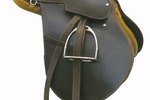Things You'll Need
Ground poles
Cavalettis
Cross rail jumps and small oxers
Warnings
If you are not comfortable jumping your horse, stick with ground poles and cavalettis. You do not want to punish your horse by pulling on his mouth over jumps or landing on his back.
Tips
If your horse jumps over small raised cavalettis, maintaining your two-point position and grabbing his mane as he goes over them will put you in a good position to help him.
Your horse’s hindquarters include several areas such as the pelvis, hip, buttocks, thighs, croup and quarters. The hindquarters must be strong enough to carry his entire body forward with impulsion in everyday riding, but several sport disciplines require significant hindquarter strength. In both Western sports and show jumping, your horse’s hindquarters must be strong enough to carry his entire weight during the quick stops and turns that characterize these sports. Strong hindquarters are also essential for collection work.

Walk up and down hills. This is one of the easiest ways to build your horse’s hindquarters and it offers the horse a break from regular arena work. It also strengthens your horse’s abdominal muscles, which helps him utilize his hind end. As your horse’s strength progresses, you can add other gaits, focusing on your horse’s balance at all times. Ride with a soft rein and make sure you adjust your weight as your horse traverses both up and down. Add more diversity to your horse’s exercise regimen by doing hill work on trail rides.
Trot over three to five ground poles, set about 5 feet apart. If this is new to your horse, begin by walking over them. Trotting over ground poles is good for overall balance, encouraging your horse to round his back and strengthen his abdominal muscles. Stay in a two-point position so you are off his back and use a loose rein so he can stretch down as he goes over the poles. Once he has mastered this, raise the poles or use adjustable cavalettis that you can set at different heights for even greater conditioning.

Ride transitions. When your horse has to transition between gaits, he has to get his hind end underneath him and carry himself in a rounder frame. Start with trot to walk and back to the trot, then proceed to canter to walk and back to canter. Make sure you are riding with a soft hand and relaxed seat so that your horse can relax his head and back to get the most out of this exercise. You can also work on transitions within each gait, asking your horse to intermittently lengthen and then shorten his stride.

Set up jumping gymnastics. This is a requirement if your horse is in any type of jumping discipline, as he must learn how to jump with his hind end, rather than throw himself over the jump with his front end. Start small by using a trot pole set about 7 or 8 feet from a small cross rail jump. Set another small jump 18 feet from the cross rail, and then put another pole 17 feet on the other side of the last jump.
References
Resources
Tips
- If your horse jumps over small raised cavalettis, maintaining your two-point position and grabbing his mane as he goes over them will put you in a good position to help him.
Warnings
- If you are not comfortable jumping your horse, stick with ground poles and cavalettis. You do not want to punish your horse by pulling on his mouth over jumps or landing on his back.
Photo Credits
-
Jupiterimages/Photos.com/Getty Images
Writer Bio
Based in Central Texas, Karen S. Johnson is a marketing professional with more than 30 years' experience and specializes in business and equestrian topics. Her articles have appeared in several trade and business publications such as the Houston Chronicle. Johnson also co-authored a series of communications publications for the U.S. Agency for International Development. She holds a Bachelor of Science in speech from UT-Austin.




